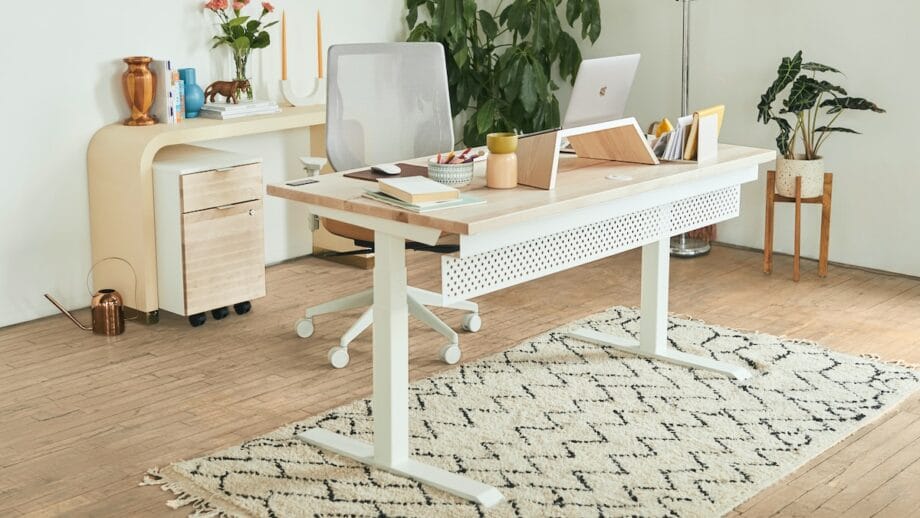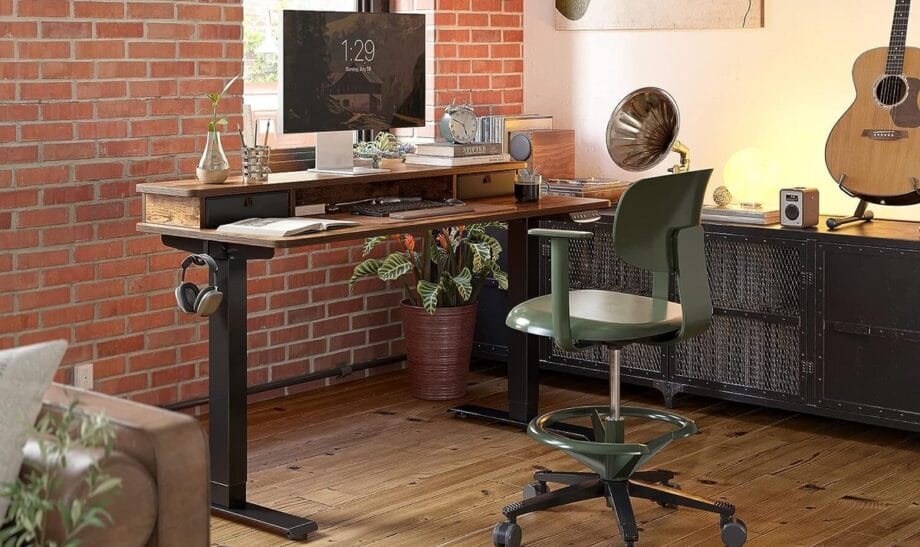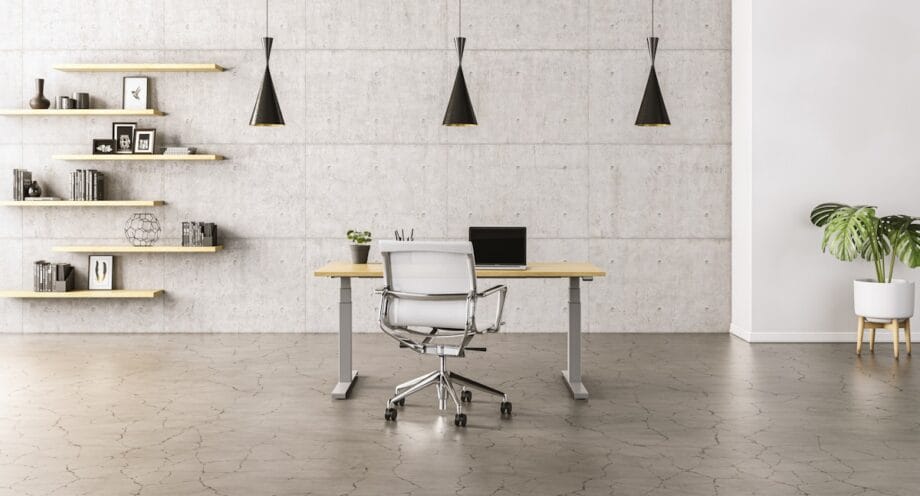The way technology teams function has been drastically altered by the quick uptake of remote work. The actual workplace, particularly the desk, is sometimes disregarded while talking about productivity, even if software programs and cloud infrastructure are frequently the main topics.
Tech teams working from home or in hybrid configurations may benefit greatly from smart ergonomic B2B office desks, which combine cutting-edge technology, creative design, and ergonomics that prioritize health.
This article examines how these desks might improve the Tech team’s effectiveness and change remote work settings.
Understanding the Smart Ergonomic B2B Office Desks

Ergonomic desks are designed to specifically benefit remote work. They increase productivity and reduce fatigue. Additionally, smart ergonomic desks reduce neck and back strain and are specifically designed for technology teams.
Standing workstations bring mobility, teamwork, and advanced tech features to satisfy the shifting needs of IT firms and startups. They go way past traditional work surfaces. At these workstations, employees can sit or stand, promoting improved circulation, reducing lower back pain, and boosting energy levels.
Key Characteristics of Smart Ergonomic Desks
The purpose of smart ergonomic desks is to improve productivity and the satisfaction of employees at work. Employees may effortlessly switch between standing and sitting positions with the help of height adjustment, which enhances circulation, reduces the strain of extended sitting, and also helps to maintain a high level of energy throughout the day.
With the integrated technologies such as USB ports, wireless charging, cable management, and posture-tracking sensors, the device organization and smooth operation are facilitated. Certain desks also provide data-driven insights, giving the teams feedback on posture and use trends to help them develop better work habits.
Employees may customize their workspace accordingly to multi-monitor configurations, accessory mounts, and storage choices for effective workflow and increased productivity.
The Remote Productivity Challenge for Tech Teams
Remote employment presents certain difficulties for IT teams. Tech teams spend a lot of time working in front of screens, which can lead not only to physical strain but also mental exhaustion. Back pain, musculoskeletal issues, and cognitive impairment can be caused due to long-duration sitting.
Due to fragmented workflows, digital distractions, and a lack of multitasking space and efficiency can be disrupted. The brainstorming and cooperation may be challenging with the most sophisticated communication technologies.
A poorly designed home offices raise the risk of burnout, lower motivation, and can cause stress. By addressing these issues, smart ergonomic desks assist in creating a more productive work environment that promotes long-term concentration and general well-being.
How Smart Ergonomics Enhances Performance
Nowadays, ergonomic design has a direct impact on productivity and cognitive function in addition to comfort. Smart ergonomics B2B office desks combine ergonomics and technology to maximize productivity for computer users. Employees will be able to rotate between jobs, facilitate the sit-stand capability, and, by doing so, promote circulation, reduce fatigue, and increase attentiveness.
With real-time feedback from ergonomic posture sensors to adjust body position immediately, chronic musculoskeletal pain could be eradicated altogether. Similarly, intelligent software applications can create micro-breaks to avoid mental fatigue and repetitive strain injuries.
Even in shared or hot-desking situations, comfort and productivity can be sustained by customizing desk and screen heights or lighting; however, the initial level can be retained across the three to keep all of them at an optimum level.
Cognitive Efficiency and Focus
The comfort of our body is physical, while the comfort of the mind is mental. Both mental performance and physical comfort have equal importance to productivity. Smart ergonomic desks are one of the examples of modern offices, which help boost the cognitive performance of employees.
During long hours of coding or designing, to help reduce the strain on the eyes, adjustable monitor mounts help in improving the position of the screens, along with modular storage and built-in cable management that helps in reducing clutter.
With adjustable color temperature and brightness, adaptive LED lighting further boosts energy, mood, and alertness. These workstations help IT teams maintain focus, work effectively on challenging projects, and continuously provide excellent outcomes by supporting the body and mind.

Innovation and Supporting Collaboration
The smart ergonomic desks promote teamwork in addition to increasing individual productivity. These desks are useful for remote tech teams that use digital brainstorming, pair programming, and video conferencing. Ergonomic camera angles are made possible by height-adjustable workstations enhance visual communication and reduce distractions from pain during business video conferences. Device power and connectivity are maintained via integrated charging ports and wireless hubs, reducing technical disruptions during teamwork.
The shared data insights on use trends and team involvement are provided via workstations equipped with monitoring software, which aids managers in locating workflow bottlenecks and resource optimization. These characteristics allow for more seamless communication, more innovation, and improved project coordination even amongst geographically separated teams.
Health Benefits Driving Productivity
A productive worker is one who is in good health. The smart ergonomic office desks are crucial for fostering both physical and mental well-being of employees. These desks are beneficial to reduce the pressure on the wrists, neck, and back by promoting proper posture.
A sit-stand functionality promotes frequent mobility in order to overcome the fatigue and energy slumps linked to long working hours. The office desks, which are easy to use and adaptable, help employees feel more in control of their surroundings and experience less stress.
The employees who practice proper posture and move during the day have better sleep, which helps to improve their ability to think clearly and concentrate the following day.
Sleep and recovery are also covered by this all-encompassing assistance. By utilizing smart ergonomic office desks, Tech teams can maintain their energy and consistently produce high-quality work by meeting their physical and mental needs.
Financial Considerations for B2B Investments
Although purchasing smart ergonomic B2B office desks may be expensive up front for IT organizations but the return on investment is substantial. These office desks reduce claims and absenteeism and other health-related costs by lowering musculoskeletal issues. Additionally, they increase employee satisfaction and retention, indicating a commitment to health in the fiercely competitive tech labor market.
Smart features and better ergonomics boost energy, increase attention and teamwork, which accelerates innovation cycles, project completion times, and yields quantifiable productivity improvements. All-around smart ergonomic workstations are much more than merely furniture; they are business assets that increase productivity, longevity, maximize performance, and enhance employee health.
Implementation Strategies
By taking a systematic, intentional implementation process for smart ergonomic quality workstations, organizations can maximize the benefits. The initial step for organizations may be to survey and interview their team to identify their needs, such as screen usage, work styles, and collaboration needs. This will ensure that the desired desk functionality is matched to actual workflows.
When making any changes to the work environment, it may be valuable to do small-scale pilots with groups of users who can provide feedback about productivity, comfort, and usability of various types of desks, before going to full implementation.
Providing staff with ergonomics training and support, and information about options for desk changes and functional features will help them fully optimize the smart workstation technology. Staff may also identify more ways to improve how the workspace is configured. Ongoing analysis of usage data and user feedback can shape changes in the workspace over time.
Some productivity and collaboration applications can integrate and assist in applying usage analytics to produce relevant management summary reporting and worker analytics to make meaningful choices to improve organizational and personal productivity.
B2B Office Desks Market
The average growth of the global office market is 8.5% per year. With the automation possibilities, the electric standing desks contribute significantly to revenue generation. On the other hand, fixed standing desks represent a sizable share and provide affordable, long-lasting options that are preferred in shared or budget-sensitive offices.
According to Pristine Market Insights, the growth in the B2B office desk market has increased due to hybrid work trends and rising demand for ergonomic and tech-enabled solutions.
Future Trends in Smart Ergonomic Desks

The evolution of smart desks is closely linked to the growth of remote work, keeping employees well. Future-ready workstations are expected to adapt with AI using user work behavior analytics and biometric indicators to set adjustments for height, lighting, and postural prompts for comfort and productivity.
Work remotely and in-office can come together using AR and VR tools, which would provide an immersive 3D collaboration experience. Eco-friendly materials and energy savings that balance efficiency gains with social responsibility are also emerging as a big consideration driving the development of the smart desk.
Additionally, workstations will be able to connect with chairs, lights, and environmental sensors via seamless IoT integration, producing fully optimized home office spaces. Technology companies can enhance employee wellness, future-proof their workplaces, and produce long-term performance amidst an increasingly dispersed and digital workforce by embracing these developments.
Ergonomic smart B2B office desks offer a whole package as they enhance remote productivity for tech teams by providing comfort, focus, collaboration, and good health. These workstations enhance posture, improve processes, and mental capacity by blending cutting-edge technology with flexible work reconfiguration and ergonomic principles. They also reduce health risks, enhance collaboration, and increase measurable output in addition to comfort.
Smart workstations are strategic investments in personnel, performance, and innovation, and forward-thinking IT businesses understand this. By using them, companies can turn remote work from a required adaptation into a competitive advantage, guaranteeing that teams stay motivated, involved, and able to regularly provide outstanding outcomes.






